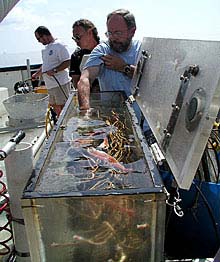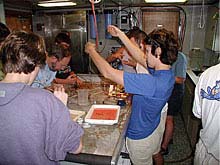
Dr. Craig Young is reaching into the biobox for some of the freshly collected tubeworms brought up from Vioska Knoll Click image for a larger view.
October 7, 2002
Rex Roettger
Teacher
While gently rolling on a flat calm sea under clear blue skies just off the Mississippi Delta, it is hard to believe that two major hurricanes passed near here within the last few weeks. Today's submersible dives, the first of this leg, provided an equally striking contrast. The first dive, on Vioska Knoll, was spectacularly successful, collecting important material for many of our scientific studies. The second dive was made at an equally promising spot where no dives had ever been made before, but we found none of the chemosynthetic animals for which we were looking, only a flat muddy plain with occasional squids, fishes and crabs. In science, it is not uncommon to be disappointed one minute and richly rewarded with the excitement of discovery in the next minute..
I had one of the most fantastic experiences today. I was given a front row seat to the ocean bottom aboard the Johnson-Sea-link submersible. The journey began as I was lowered into the water. Sitting in the front of the submersible is like sitting in a glass bubble under water. It provides you with a great view of your surroundings. As we were descending, my eyes scanned the waters for any signs of life but I kept an eye on the depth gauge to see how deep we were as well. Slowly the light began to fade until it became pitch black, around 300 feet. Then the fireworks begin as the bioluminescent creatures started to react to the

Freshly collected tubeworms were dissected for various experiments to be performed during the cruise. Click image for larger view.
disturbance of the sinking submersible. This continued for the next twenty minutes until we reached the ocean bottom. The depth gauge read 2,668 ft, and the temperature of the water was a chilly 5.8 degrees Celsius. As I surveyed the surroundings, it soon became apparent that we were on muddy plain and we were not going to find the chemosynthetic animals that we had hoped to find. So we searched the area for any organisms that could be useful to the researchers aboard the ship. We collected a couple of different organisms such as squid, a seastar and a couple of fish. On the return trip to the surface, the light show from the bioluminescence was just a spectacular. This dive turned out to be one of the most spectacular trips I have ever taken in my life. I was in another world that very few people have ever witnessed firsthand. I also realized that we are just beginning to understand the complexity of the deep ocean.
Sign up for the Ocean Explorer E-mail Update List.























